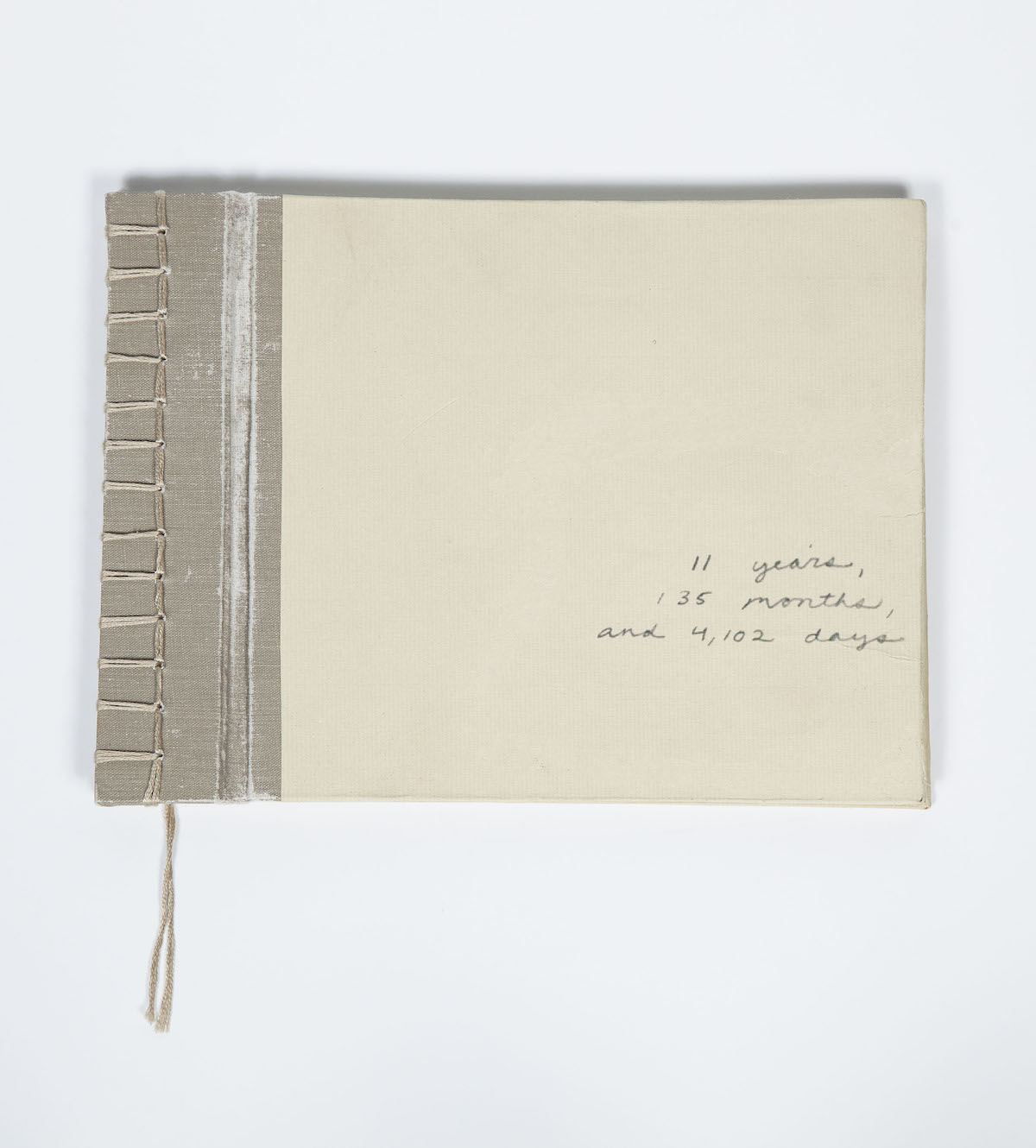“Always made with love, my art seeks to be a vehicle and catalyst for healing, reconciliation, and hope.”
—Ashley Minner
Made with tender care, the book is bound with even-handed stitching, its warm-white cover bare but for the careful cursive words occupying the lower right hand corner, spelling out the work’s title:
11 years,
135 months,
and 4,102 days
“I was in an artist book class in 2005. That’s when I made it,” she recalls. “I was thinking about my uncle Jim.”
Jim had died before Ashley came into the world (the title refers to the time between the two events). Though Ashley never knew her uncle, she grieved him nonetheless.
“I had grown up hearing stories about him,” she says. “It hadn’t occurred to me to ask where he was until I was in middle school. I was told he had died long before I was born, and I was devastated—I cried all day.” Suddenly, there was a chasm there.
It’s a chasm her work names—and overcomes.
The book’s interior includes her uncle’s Merchant Marine card affixed to one page, a photo of Ashley superimposed over half of Jim’s headshot image. The two become one person: connected.
“It was like our faces matched.”
With this art—in this gesture—Ashley offers an alternative to the reality of physical separation.
“I may have never known my uncle,” says Ashley, “but I feel he is very much with me all the time anyway.”
An enrolled member in the Lumbee Tribe of North Carolina, Ashley grew up in a household steeped in a legacy of reminiscence. A large contingent of Lumbees moved to East Baltimore following World War II, including Ashley’s maternal grandfather. Additionally, the rest of Ashley’s non-Native-American family left behind lives and pasts when they too came to Baltimore from the South two generations ago.
“I can’t imagine being so deeply rooted in a place—all the people and things you know—and then having to make the decision to go so far away to live. I grew up with my family always talking about where our people are buried, what they used to do, the funny stories, the sad ones, how people died.”
Remembering, honoring, celebrating—these are ways to challenge the seeming evanescence of our connection to our ancestors and lost loved ones.
And so is making art, as Ashley discovered in college.
“Everything I made was the same theme. We’d be given a prompt in class, and always the idea of paying tribute seemed so important—marking the fact that loved ones are with us even if they’re not physically present; giving a shape to the absence.”
Ashley’s website is replete with projects extending upon what she first began doing years ago as a shy young art student: Trace: The Presence of Absence, an undertaking “to honor the continuous presence of loved ones in the things and spaces that remain”; Lumbee Oral Histories, an ongoing initiative “to record oral histories of Lumbee elders”; Exquisite Lumbees, a portrait project in which Ashley and others give “viewers a glimpse into our hopes for one other and depths of ourselves.”
To be sure people are seen and connected, and do not disappear—that is Ashley’s purpose as an artist.
“I’m interested in making obvious both our humanity and our divinity, as well as the fact we are all related.”
Her heritage of nostalgia has made Ashley who she is—it is the wellspring of her identity as an artist, and of the work she does beyond her studio, such as writing about community cohesion, and restoring memory and preserving history in her leadership role in her tribe. In all of it, there is resistance to time’s scattering effect. In reaching and binding across time, she bridges gaps and illuminates our abiding bonds.
For her the stakes are high, the work as sacred as laying flowers at a grave: it must be done with tender care and loving respect.
Ashley takes on the weightiness of death and departure, and through her art offers the lift of hope—not only for her, but for us as well, for we each inhabit a world rife with apartness and pain. For me, the redeeming promise of 11 years, 135 months, and 4,102 days is that, no matter how wide the chasm of time, my future grandchildren will know and love their aunt, my dear Elisif.
And that is balm to my grieving heart.
—Peter
Dr. Ashley Minner is a community-based artist and folklorist in Baltimore currently working as Assistant Curator for History and Culture at the Smithsonian National Museum of the American Indian in Washington, D.C. On Monday, November 15, 8:00 P.M., Ashley joins Peter in the online event Phoenix Rising: Reimagine Grief, Growth and Action, and on Monday, November 22, 6:00 P.M., she participates in the virtual launch of the Guide to Indigenous Baltimore, an app that is the culmination of a mapping project Ashley began working on in 2016—you can contact Ashley to learn more and for details on how to register.

